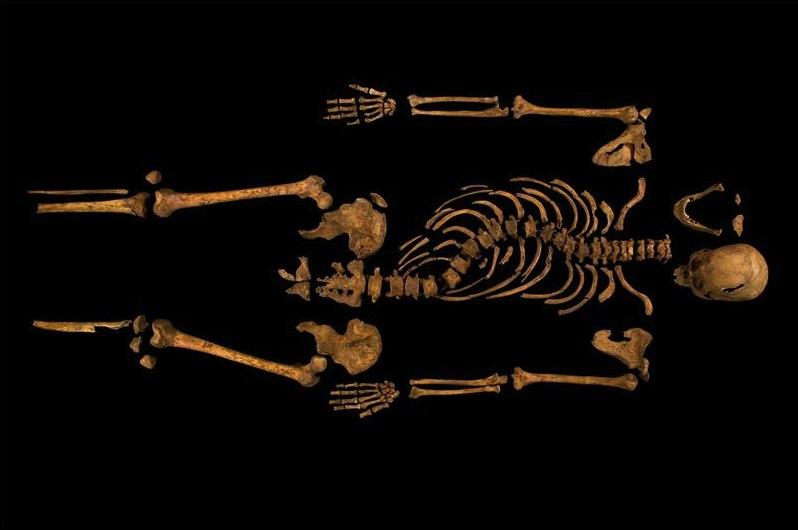The combined operation involved geneticists, doctors dealing with the structure of the skeleton, forensics and other experts - all from the University of Leicester

The University of Leicester has confirmed that it has discovered the remains of King Richard III.
At a press conference, experts in various fields revealed the remains buried in Leicester city center as those of the last of the Lancaster dynasty who died in 1485.
In-depth scientific investigations have confirmed that strong circumstantial evidence leads researchers to conclude that the skeleton found at the Gray Friars Church site in Leicester was indeed that of King Richard III.
The researchers from the University of Leicester produced a variety of evidence - including DNA analysis, radioactive carbon tests to determine the age of the skeleton, as well as an examination of the skeleton itself proving the identity of the skeleton.
Archaeologist Richard Buckley of the University of Leicester, the lead researcher among the archaeologists involved in the discovery said: "It is the academic conclusion of the University of Leicester that the man whose skeleton was exhumed from Gerry Friars in August 2012 is indeed Richard III. "It is an honor and a privilege for all of us to have been at the center of the academic project, which received great interest from the public in the UK and around the world. Rarely, the results of academic research have been so expected."
Geneticist Dr. Tory King, also from the University of Leicester, confirmed that the DNA from the skeleton resembles that of two of the king's known descendants - the Canadian furniture maker Michael Ibsen and a second person who asked to remain private.
Dr. King added: "The DNA sequence obtained from the skeletal remains found at Gerry Friars was compared with two of King Richard III's maternal descendants (ie Richard's sisters). We were thrilled to discover that there is a DNA match between the maternal DNA in Richard III's family and the skeletal remains found in the excavations at Gray Friars."
The bone researcher (osteocologist) Dr. Joe Appleby said that according to the tests it is the skeleton of a person who died at some age between his late twenties and late thirties. Richard III was 32 years old when he was killed at the Battle of Bosworth in 1485. The skeleton also indicates that this is a man with a thin physical structure and that he suffered from scoliosis. Apparently one shoulder was higher than the other shoulder. This fits with accounts of Richard III's appearance from those days.
The skeleton also shows traces of trauma indicating that the man died after receiving one or two large wounds on the back of the skull, possibly caused by a sword or spear. This figure is also consistent with the evidence that Richard was killed after being stabbed in the back of the head.
The examination of the skeleton showed evidence of non-fatal wounds to the head, ribs and pelvis, which the scientists estimate was caused by a wound along the right buttock that was apparently inflicted by people who wanted to humiliate him after his death.
Dr. Appleby's assessments are also backed up by radiological tests done by the Department of Forensic Sciences, also from the University of Leicester.
Dr. Appleby, from the University's School of Archeology and Ancient History says: "The skeleton has a large number of unusual features: its thin build, the scoliosis, and the trauma wounds from the battle. All of these are consistent with the knowledge we have about Richard III in his life and the circumstances of his death. The combination of all these data together provides reasonably convincing evidence for his identification as Richard III.
The research was conducted by the University of Leicester, Leicester City and the Richard III Society. The search for the remains of Richard III is also the subject of A documentary film produced for the British Channel 4 that aired last week (February 4).

One response
The genetic comparison is the most impressive. Richard is the last descendant of the House of York/Plantagenet.
Those who know the Wars of the Roses between the House of York and the House of Lancaster. At that time there were no hi-tech companies to take over but estates and estates and there was no democratic regime but feudalism. The wars were about the control of the countries.
The entry on Wikipedia in English is very interesting and in Hebrew a little less so. After his death, Richard was accused of moral crimes by the historians on behalf of his rival. Murder of 2 heirs to the throne, rape of a woman to obtain legitimacy as a ruler with descendants from the royal family. A more objective historical examination shows that most/all accusations are likely false. In addition, Richard was killed in battle, at the head of his army. It means that he set a personal example in battle. After his death, I think
No longer did the kings of England stand at the front in battle.